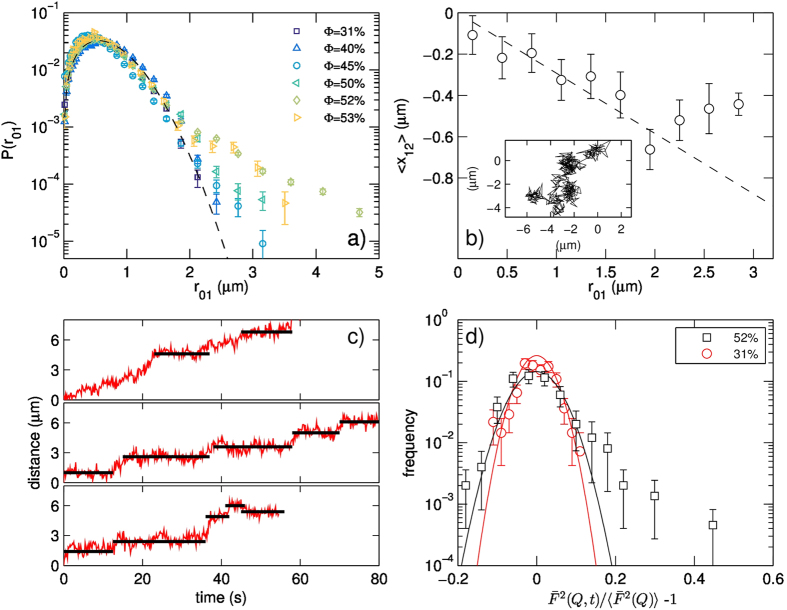Figure 5.
(a) Self part of the Van Hove Correlation functions of the trajectories reported in Fig. 2, calculated for  , for increasing values of
, for increasing values of  . The values of
. The values of  is chosen to correspond to the sub-diffusive trend of the mean square displacement found at high
is chosen to correspond to the sub-diffusive trend of the mean square displacement found at high  . At
. At  the data points lie on a Gaussian curve (dashed line), compatible with Brownian diffusion. At higher concentration, the distribution develops tails that are broader than in a Gaussian, indicating more frequent occurrence of long-range jumps. This is in agreement with the dynamical arrest picture. (b) The average value of the projection
the data points lie on a Gaussian curve (dashed line), compatible with Brownian diffusion. At higher concentration, the distribution develops tails that are broader than in a Gaussian, indicating more frequent occurrence of long-range jumps. This is in agreement with the dynamical arrest picture. (b) The average value of the projection  of a step
of a step  along the direction of the previous step
along the direction of the previous step  is reported as a function of the size
is reported as a function of the size  of the first step. Steps have been measured at
of the first step. Steps have been measured at  over time interval
over time interval  . The data follows a linear decrease (dashed line) which implies anticorrelation between the first and second step: this happens when one of the tracked object hits the “cage” of the surrounding neighbors and is pushed back towards the previous position. A deviation from the linear trend is observed for
. The data follows a linear decrease (dashed line) which implies anticorrelation between the first and second step: this happens when one of the tracked object hits the “cage” of the surrounding neighbors and is pushed back towards the previous position. A deviation from the linear trend is observed for  ; this length corresponds to the size of the “cage”. The inset shows a typical trajectory measured at
; this length corresponds to the size of the “cage”. The inset shows a typical trajectory measured at  ; the trajectory presents clusters of positions that are roughly
; the trajectory presents clusters of positions that are roughly  in size. (c) Displacements of three different objects measured at
in size. (c) Displacements of three different objects measured at  , reported as a function of time. They present long periods of short range movements around a stationary position, followed by sudden jumps. Black lines highlight the time intervals between successive jumps. (d) Histogram of temporal intensity fluctuations of the Fourier transform of successive images for two values of
, reported as a function of time. They present long periods of short range movements around a stationary position, followed by sudden jumps. Black lines highlight the time intervals between successive jumps. (d) Histogram of temporal intensity fluctuations of the Fourier transform of successive images for two values of  with respect to the time-averaged value, measured at
with respect to the time-averaged value, measured at  . While at
. While at  the fluctuation histogram is compatible with a Gaussian curve (solid red line), at
the fluctuation histogram is compatible with a Gaussian curve (solid red line), at  the distribution is characterized by a tail, which is broader than Gaussian, indicating that rearrangement events are taking place in the layer.
the distribution is characterized by a tail, which is broader than Gaussian, indicating that rearrangement events are taking place in the layer.

